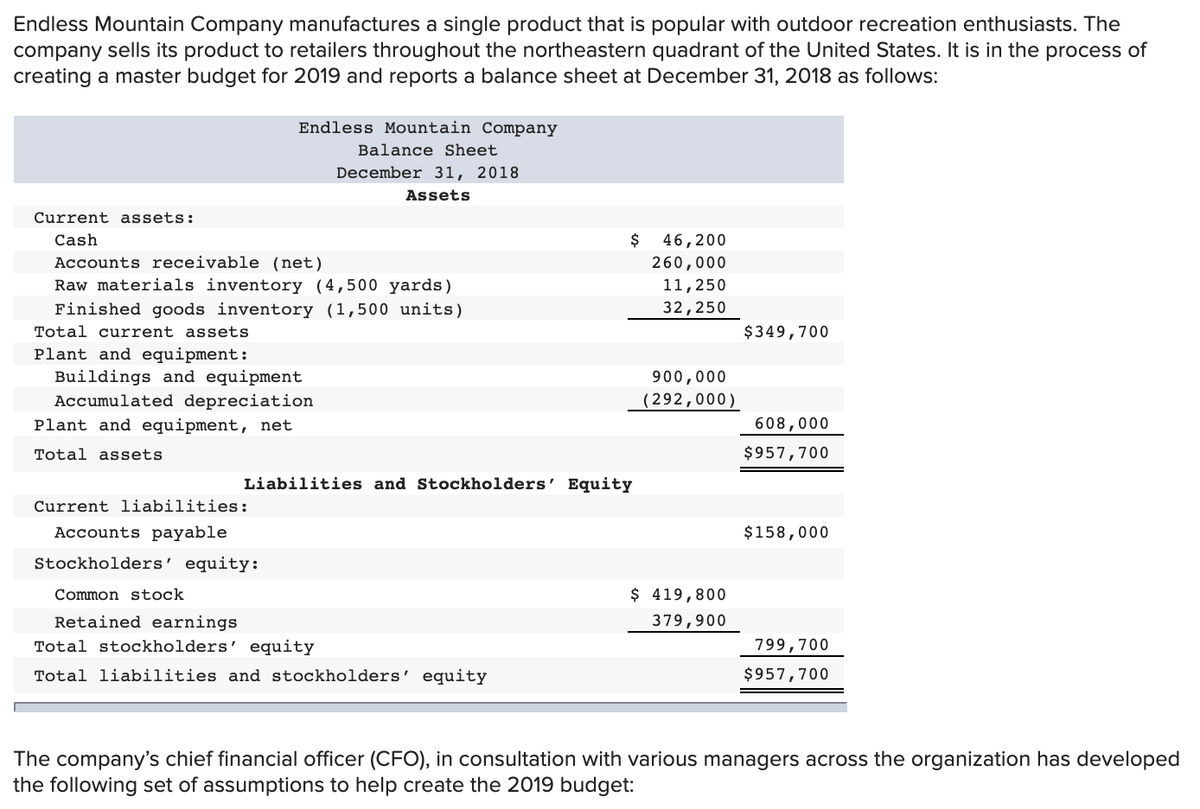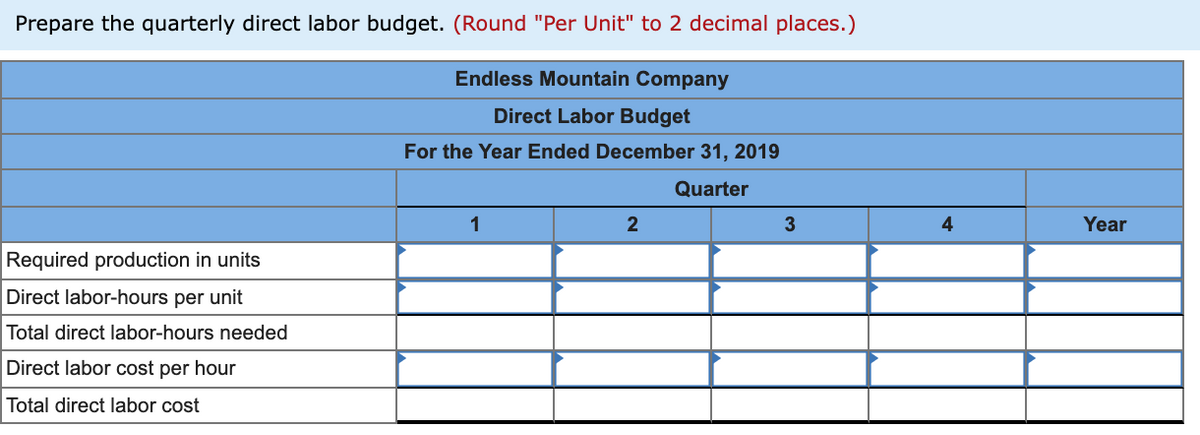1. The budgeted unit sales are 12,000 units, 37,000 units, 15,000 units, and 25,000 units for quarters 1-4, respectively. Notice that the company experiences peak sales in the second and fourth quarters. The budgeted selling price for the year is $32 per unit. The budgeted unit sales for the first quarter of 2020 is 13,000 units. 2. All sales are on credit. Uncollectible accounts are negligible and can be ignored. Seventy-five percent of all credit sales are collected in the quarter of the sale and 25% are collected in the subsequent quarter. 3. Each quarter's ending finished goods inventory should equal 15% of the next quarter's unit sales. 4. Each unit of finished goods requires 3.5 yards of raw material that costs $3.00 per yard. Each quarter's ending raw materials inventory should equal 10% of the next quarter's production needs. The estimated ending raw materials inventory on December 31, 2019 is 5,000 yards. 5. Seventy percent of each quarter's purchases are paid for in the quarter of purchase. The remaining 30% of each quarter's purchases are paid in the following quarter. 6. Direct laborers are paid $18 an hour and each unit of finished goods requires 0.25 direct labor-hours to complete. All direct labor costs are paid in the quarter incurred. 7. The budgeted variable manufacturing overhead per direct labor-hour is $3.00. The quarterly fixed manufacturing overhead is $150,000 including $20,000 of depreciation on equipment. The number of direct labor-hours is used as the allocation base for the budgeted plantwide overhead rate. All overhead costs (excluding depreciation) are paid in the quarter incurred. 8. The budgeted variable selling and administrative expense is $1.25 per unit sold. The fixed selling and administrative expenses per quarter include advertising ($25,000), executive salaries ($64,000), insurance ($12,000), property tax ($8,000), and depreciation expense ($8,000). All selling and administrative expenses (excluding depreciation) are paid in the quarter incurred. 9. The company plans to maintain a minimum cash balance at the end of each quarter of $30,000. Assume that any borrowings take place on the first day of the quarter. To the extent possible, the company will repay principal and interest on any borrowings on the last day of the fourth quarter. The company's lender imposes a simple interest rate of 3% per quarter on any borrowings. 10. Dividends of $15,000 will be declared and paid in each quarter. 11. The company uses a last-in, first-out (LIFO) inventory flow assumption. This means that the most recently purchased raw materials are the "first-out" to production and the most recently completed finished goods are the "first-out" to customers.
Master Budget
A master budget can be defined as an estimation of the revenue earned or expenses incurred over a specified period of time in the future and it is generally prepared on a periodic basis which can be either monthly, quarterly, half-yearly, or annually. It helps a business, an organization, or even an individual to manage the money effectively. A budget also helps in monitoring the performance of the people in the organization and helps in better decision-making.
Sales Budget and Selling
A budget is a financial plan designed by an undertaking for a definite period in future which acts as a major contributor towards enhancing the financial success of the business undertaking. The budget generally takes into account both current and future income and expenses.
1. The budgeted unit sales are 12,000 units, 37,000 units, 15,000 units, and 25,000 units for quarters 1-4, respectively.
Notice that the company experiences peak sales in the second and fourth quarters. The budgeted selling price for the
year is $32 per unit. The budgeted unit sales for the first quarter of 2020 is 13,000 units.
2. All sales are on credit. Uncollectible accounts are negligible and can be ignored. Seventy-five percent of all credit sales
are collected in the quarter of the sale and 25% are collected in the subsequent quarter.
3. Each quarter's ending finished goods inventory should equal 15% of the next quarter's unit sales.
4. Each unit of finished goods requires 3.5 yards of raw material that costs $3.00 per yard. Each quarter's ending raw
materials inventory should equal 10% of the next quarter's production needs. The estimated ending raw materials
inventory on December 31, 2019 is 5,000 yards.
5. Seventy percent of each quarter's purchases are paid for in the quarter of purchase. The remaining 30% of each
quarter's purchases are paid in the following quarter.
6. Direct laborers are paid $18 an hour and each unit of finished goods requires 0.25 direct labor-hours to complete. All
direct labor costs are paid in the quarter incurred.
7. The budgeted variable manufacturing
overhead is $150,000 including $20,000 of
the allocation base for the budgeted plantwide overhead rate. All overhead costs (excluding depreciation) are paid in
the quarter incurred.
8. The budgeted variable selling and administrative expense is $1.25 per unit sold. The fixed selling and administrative
expenses per quarter include advertising ($25,000), executive salaries ($64,000), insurance ($12,000), property tax
($8,000), and depreciation expense ($8,000). All selling and administrative expenses (excluding depreciation) are paid
in the quarter incurred.
9. The company plans to maintain a minimum cash balance at the end of each quarter of $30,000. Assume that any
borrowings take place on the first day of the quarter. To the extent possible, the company will repay principal and
interest on any borrowings on the last day of the fourth quarter. The company's lender imposes a simple interest rate of
3% per quarter on any borrowings.
10. Dividends of $15,000 will be declared and paid in each quarter.
11. The company uses a last-in, first-out (LIFO) inventory flow assumption. This means that the most recently purchased
raw materials are the "first-out" to production and the most recently completed finished goods are the "first-out" to
customers.


Trending now
This is a popular solution!
Step by step
Solved in 2 steps with 2 images









